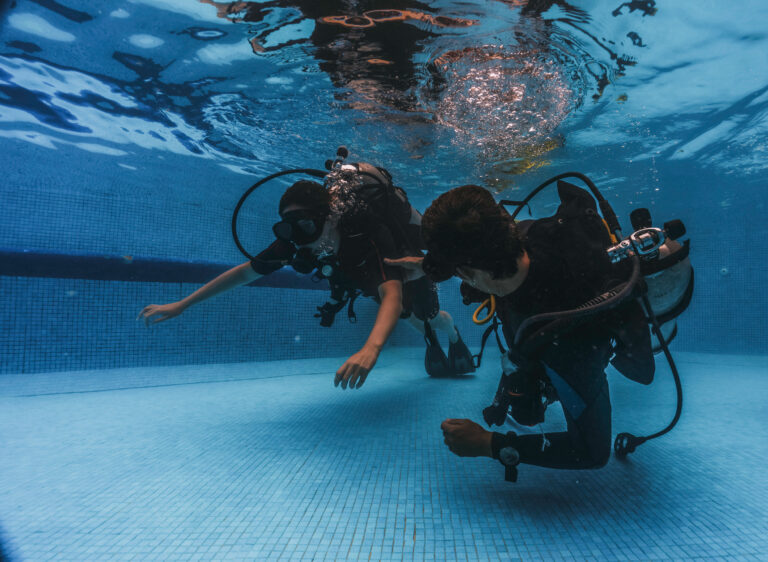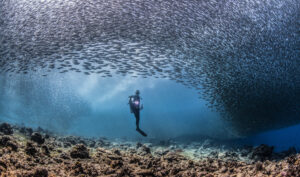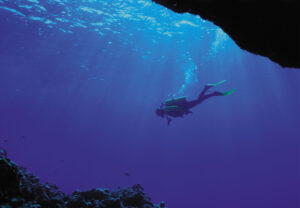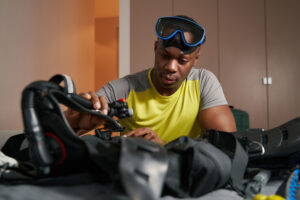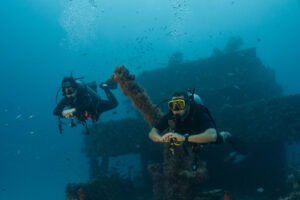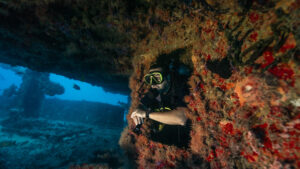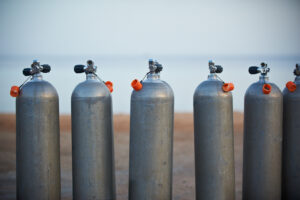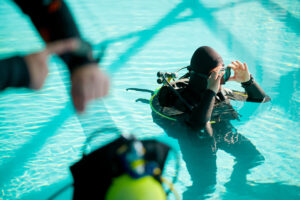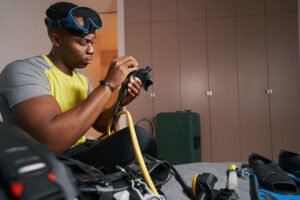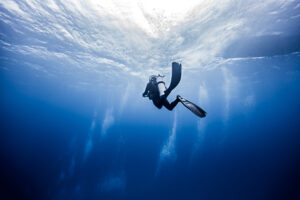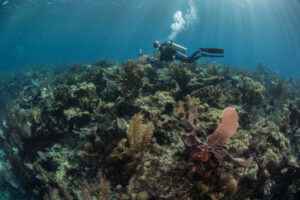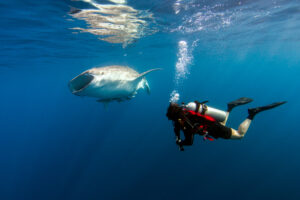What is a Primary Light?
A primary light is an essential tool for scuba divers, serving as the main source of illumination during underwater excursions. The role of a primary light extends beyond simply illuminating the surroundings; it enhances visibility, aids in navigation, and significantly contributes to safety. Whether diving in murky waters, exploring intricate underwater caves, or embarking on a night dive, a reliable primary light ensures that divers can see their environment clearly, identify potential hazards, and communicate effectively with their diving partners. Understanding the importance and functionality of primary lights is crucial for anyone engaging in scuba diving activities.
Historical Development of Primary Lights
The journey of underwater lighting began with rudimentary solutions that were far from ideal. Early divers relied on basic handheld torches, often repurposed from land-based uses. These initial lights were limited in their effectiveness, offering poor illumination and struggling with waterproofing issues. Divers had to contend with bulky, unreliable equipment that could fail under pressure, creating a need for more specialized solutions.
The 20th century marked significant advancements in dive light technology. The introduction of sealed beam lights provided better waterproofing and durability, although they were still heavy and cumbersome. The transition from incandescent bulbs to halogen lights offered brighter and more reliable illumination, albeit with higher power consumption and shorter burn times. These lights, while an improvement, still left much to be desired in terms of efficiency and practicality.
The advent of LED (Light Emitting Diode) technology revolutionized primary lights for divers. LEDs offered several advantages: they were more energy-efficient, produced brighter light, had longer lifespans, and were more compact. This technological leap allowed manufacturers to create lights that were not only more powerful but also lighter and more durable. Modern primary lights now come equipped with advanced features such as adjustable beam settings, multiple power modes, and rechargeable batteries, making them indispensable tools for divers of all levels.
Types of Primary Lights
Primary lights for scuba diving come in various forms, each designed to meet specific needs and preferences. Handheld lights are popular for their simplicity and versatility. They are easy to carry and can be used in a wide range of diving conditions. These lights typically feature ergonomic designs, making them comfortable to hold for extended periods. Despite their compact size, many handheld lights offer powerful illumination and come with adjustable beam settings.
Canister lights represent another significant category of primary lights. These lights consist of a separate battery canister connected to the light head via a cable. Canister lights are favored for technical and cave diving due to their extended burn times and robust power output. The design allows divers to secure the canister to their equipment, distributing the weight more evenly and reducing hand fatigue. Canister lights often include features such as multiple brightness levels and wide-angle beams, making them suitable for challenging underwater environments.
When it comes to power sources, primary lights can be either rechargeable or battery-operated. Rechargeable lights are convenient and cost-effective in the long run, as they eliminate the need for disposable batteries. Modern rechargeable lights typically use lithium-ion batteries, which offer high energy density and reliability. On the other hand, battery-operated lights provide the advantage of quickly swapping batteries if the power runs out during a dive. This flexibility can be crucial for longer or multiple dives in remote locations where recharging may not be possible.
The beam type is another important consideration. Divers can choose between spot beams, which concentrate light into a narrow, intense beam, and flood beams, which spread light over a wider area. Spot beams are ideal for penetrating through murky water and for focusing on specific objects or areas. Flood beams, however, are better suited for general illumination and for environments where a broader view is needed. Many modern primary lights offer adjustable beam settings, allowing divers to switch between spot and flood modes as required.
Technical Specifications
Understanding the technical specifications of primary lights is essential for selecting the right tool for underwater exploration. Lumen output, a measure of the total amount of visible light emitted, is a key factor. Higher lumens indicate a brighter light, which is beneficial in low-visibility conditions. However, it’s important to balance brightness with burn time, as extremely high lumen outputs can drain the battery more quickly.
Beam angle is another critical specification. A narrow beam angle, typically between 6 to 20 degrees, produces a concentrated, intense light that can cut through murky water and highlight specific targets. In contrast, a wide beam angle, ranging from 20 to 120 degrees, provides broader illumination, which is useful for general visibility and situational awareness. Divers should choose a beam angle based on the type of diving they plan to do and the typical underwater conditions they will encounter.
Burn time, or the duration a light can operate on a single charge or set of batteries, is crucial for planning safe dives. Longer burn times are especially important for deep, technical, or extended dives. Many modern primary lights feature multiple power settings, allowing divers to adjust the brightness and extend the burn time as needed. Understanding the trade-off between brightness and burn time is vital for effective light management.
The depth rating of a primary light indicates how deep it can be used without risk of failure. This specification ensures that the light can withstand the pressure at the intended dive depth. Divers should always check the depth rating to ensure that their light is suitable for their planned dives. Materials and build quality also play a significant role in a light’s durability and performance. High-quality primary lights are typically made from robust materials such as anodized aluminum or high-strength plastics, ensuring they can endure the harsh underwater environment.
Operational Guidelines
Using primary lights effectively and safely requires adherence to best practices. Before a dive, it’s essential to inspect the light for any signs of damage or wear, ensuring that all seals and O-rings are intact and properly lubricated. Regular maintenance, such as cleaning the lens and checking the battery contacts, helps prevent malfunctions and extends the life of the light.
Safety precautions include understanding the light’s operating modes and how to switch between them quickly. Many lights have multiple brightness settings, strobe functions, or SOS signals, which can be vital in emergency situations. Divers should familiarize themselves with these features and practice using them before diving.
Proper handling and storage of primary lights are also crucial. After each dive, rinsing the light in fresh water helps remove salt, sand, and other debris that can cause damage. Storing the light in a dry, cool place away from direct sunlight prevents degradation of materials and battery components. For rechargeable lights, it’s important to follow the manufacturer’s guidelines for charging and storage to maintain battery health.
When diving, positioning the primary light correctly can enhance visibility and reduce glare. Holding the light at an angle rather than directly in front of the face minimizes backscatter, the reflection of particles in the water, which can obscure vision. For hands-free operation, mounting options such as Goodman handles or helmet mounts are available, allowing divers to use both hands for other tasks while maintaining effective illumination.
Selection Criteria
Choosing the right primary light involves considering various factors that align with the diver’s needs and diving conditions. The diving environment plays a significant role in determining the appropriate light. For instance, cave and wreck divers may prioritize canister lights with long burn times and robust construction, while recreational night divers might opt for compact, handheld lights with adjustable beams.
Personal diving style and preferences also influence the selection process. Divers who frequently engage in photography or videography may need lights with wider beams and consistent color temperatures to ensure accurate and appealing visuals. Those diving in colder waters might prefer lights with higher lumen outputs to compensate for reduced natural light penetration.
Compatibility with other diving equipment is another important consideration. Divers should ensure that their primary light can be securely mounted or integrated with their existing gear, such as harnesses, helmets, or cameras. Ease of use, including the accessibility of controls and the ergonomics of the light, should also be assessed, especially for extended dives or technical diving scenarios.
Balancing cost, functionality, and durability is key to making an informed decision. While high-end lights offer advanced features and superior performance, budget-friendly options can still provide reliable illumination for recreational diving. It’s important to evaluate the overall value, considering factors such as warranty, customer support, and user reviews. Investing in a quality primary light tailored to the diver’s specific needs ensures a safer and more enjoyable underwater experience.
Key Takeaways
Primary lights are indispensable tools for scuba divers, enhancing visibility, safety, and communication underwater. From their historical evolution to modern technological advancements, primary lights have become more efficient, durable, and versatile. Divers can choose from various types and specifications based on their diving environment, personal preferences, and equipment compatibility. Proper use, maintenance, and selection of primary lights are crucial for ensuring a successful and safe diving experience.

